UNIT 5 REVIEW HUMAN GEOGRAPHY
4.5(11)
4.5(11)
Card Sorting
1/48
Earn XP
Description and Tags
Created in 2023 for P. Hammond's AP Human Geography course.
Study Analytics
Name | Mastery | Learn | Test | Matching | Spaced |
|---|
No study sessions yet.
49 Terms
1
New cards
Agricultural Hearths
also known as centers of domestication; places where the first agricultural revolution occurred; occurances are independent of each other
EX: Fertile Crescent and the Nile, Indus River Valley, Southeast Asia, Central America (5.1)
EX: Fertile Crescent and the Nile, Indus River Valley, Southeast Asia, Central America (5.1)
2
New cards
Extensive vs. Intensive Land Use
__extensive__– uses a large area; low inputs of labor, low output
__intensive__– uses a small area; high inputs of labor, high output (5.1)
__intensive__– uses a small area; high inputs of labor, high output (5.1)
3
New cards
1st Agricultural Revolution
also known as the neolithic revolution; **first domestication of plants and animals** other than dogs; *decreased* human health upon adoption of agriculture
\~12,000 years ago
__hallmarks__: mostly subsistence, simple tools, manual labor (5.1)
\~12,000 years ago
__hallmarks__: mostly subsistence, simple tools, manual labor (5.1)
4
New cards
2nd Agricultural Revolution
**utilized the advances of the industrial revolution**; allowed for fewer, larger, more productive farms and declined the need for large numbers of farm laborers, as well as increased food supply, diets, life spans, and populations; created inventions like the seed drill and barbed wire
started in the 1700s
__hallmarks__: mechanization, transportation improvements, refrigeration, natural fertilizers, soil science, increased selective breeding of plants and animals, large scale irrigation projects (5.1)
started in the 1700s
__hallmarks__: mechanization, transportation improvements, refrigeration, natural fertilizers, soil science, increased selective breeding of plants and animals, large scale irrigation projects (5.1)
5
New cards
Enclosure Movement
occurred during 2nd agricultural revolution; laws enacted (starting in Britain) that allowed for **more private ownership of the commons**; allowed wealthy farmers to purchase and enclose lands, which made it nearly impossible for underclasses to farm and pushed them to cities to fight for industrial jobs (5.1)
6
New cards
3rd Agricultural Revolution
also known as the green revolution; triggered by Norman Borlaug when he **genetically modified** wheat and **increased carrying capacity** and the ability to operate at an economy of scale with technology
started in the 1960s
__hallmarks__: development of higher-yielding, disease-resistant, and faster growing varieties of grains; double-cropping; **increased use of fertilizers and pesticides**; agribusiness model/industrial agriculture and factory farms; hybrids; GMOs (5.2)
started in the 1960s
__hallmarks__: development of higher-yielding, disease-resistant, and faster growing varieties of grains; double-cropping; **increased use of fertilizers and pesticides**; agribusiness model/industrial agriculture and factory farms; hybrids; GMOs (5.2)
7
New cards
Hybrids
breeding two plants that have desirable characteristics (5.2)
8
New cards
GMOs
crops whose genetic structure has been altered to make it more useful and efficient for human purposes
__positives__: increased yield, disease resistant, herbicide resistant, weather resistant, spoilage resistant, more nutritious
__negatives__: seeds are expensive, African export issues, potential health problems have not been adequately studied (5.2 & 5.5)
__positives__: increased yield, disease resistant, herbicide resistant, weather resistant, spoilage resistant, more nutritious
__negatives__: seeds are expensive, African export issues, potential health problems have not been adequately studied (5.2 & 5.5)
9
New cards
Negatives of the Green Revolution
environmental damage; lack of sustained investment; disregard for local needs; intensity of land use drained soil of natural nutrients; pollution from increased mechanization (5.2)
10
New cards
Causes for Africa’s Failure in the Green Revolution
diverse soils and climates; seed and fertilizer development was complicated and expensive; harsh environmental conditions (insects, viral strains, etc); African staple crops not often included in hybrid research; political turmoil; increasing instability and food insecurity (5.2)
11
New cards
Subsistence vs. Commercial Agriculture
__subsistence__– farmers focus on raising the food they need to survive
__commercial__– farmers focus on raising one specific crop to sell for profit (5.3)
__commercial__– farmers focus on raising one specific crop to sell for profit (5.3)
12
New cards
Land Use Methods + Economic Interaction
*see table above* (5.3)

13
New cards
Pastoral Nomadism
AGRICULTURAL REGION!
nomads **move their herds to different pastures within their territory**
typically in arid or semi-arid regions with cattle, goats, camels, reindeer, yaks, sheep, and horses (5.3)
nomads **move their herds to different pastures within their territory**
typically in arid or semi-arid regions with cattle, goats, camels, reindeer, yaks, sheep, and horses (5.3)
14
New cards
Shifting Cultivation
AGRICULTURAL REGION!
when farmers **clear the land by burning vegetation**, which enriches the soil by adding nitrogen to it
typically in tropical regions with rice, maize, millet, and sorghum
**viewed as destructive and primitive and is linked to the destruction of rainforests and climate change* (5.3)
when farmers **clear the land by burning vegetation**, which enriches the soil by adding nitrogen to it
typically in tropical regions with rice, maize, millet, and sorghum
**viewed as destructive and primitive and is linked to the destruction of rainforests and climate change* (5.3)
15
New cards
Plantations
AGRICULTURAL REGION!
**large, monocultural commercial farms** that typically labor intensive and exploitative of cheap labor
typically in the tropics or other hot, humid climates with substantial precipitation; common crops are coffee, cocoa, rubber, sugarcane, bananas, tobacco, tea, coconuts, palm oil, and cotton (5.3)
**large, monocultural commercial farms** that typically labor intensive and exploitative of cheap labor
typically in the tropics or other hot, humid climates with substantial precipitation; common crops are coffee, cocoa, rubber, sugarcane, bananas, tobacco, tea, coconuts, palm oil, and cotton (5.3)
16
New cards
Mixed Crop/Livestock Farming
AGRICULTURAL REGION!
**crops and livestock located near each other**; livestock are fed with grown grains and used for slaughter or dairy, manure is used as fertilizer; **allows farmers to work year-round**
commonly found in the United States, Europe, and Argentine; grains are commonly corn or soybeans in the US (5.3)
**crops and livestock located near each other**; livestock are fed with grown grains and used for slaughter or dairy, manure is used as fertilizer; **allows farmers to work year-round**
commonly found in the United States, Europe, and Argentine; grains are commonly corn or soybeans in the US (5.3)
17
New cards
Grain Farming
AGRICULTURAL REGION!
farmers **raise wheat in old prairie or plains land to be consumed by people**
typically in regions too dry for mixed crop agriculture; China, India, Russia, and the United States are the world’s top wheat producers
either *spring wheat* (planted in early spring, harvested early autumn; colder regions) or *winter wheat* (planted in fall, harvested early summer; warmer regions) (5.3)
farmers **raise wheat in old prairie or plains land to be consumed by people**
typically in regions too dry for mixed crop agriculture; China, India, Russia, and the United States are the world’s top wheat producers
either *spring wheat* (planted in early spring, harvested early autumn; colder regions) or *winter wheat* (planted in fall, harvested early summer; warmer regions) (5.3)
18
New cards
Commercial Gardening
AGRICULTURAL REGION!
farming done for **products that are mostly sold to companies for canning and freezing** for increased shelf-life
typically in areas with long growing seasons, like the American southwest and southeast (5.3)
farming done for **products that are mostly sold to companies for canning and freezing** for increased shelf-life
typically in areas with long growing seasons, like the American southwest and southeast (5.3)
19
New cards
Dairy Farming
AGRICULTURAL REGION!
farms that **specialize in the production of milk and dairy products**; mostly corporatized nowadays
most commonly located in the US, Canada, and Europe; traditionally localized due to perishable nature of products, and this pattern carries over in the developing world (5.3)
farms that **specialize in the production of milk and dairy products**; mostly corporatized nowadays
most commonly located in the US, Canada, and Europe; traditionally localized due to perishable nature of products, and this pattern carries over in the developing world (5.3)
20
New cards
Milkshed
the ring surrounding a city from which milk can be supplied without spoiling (5.3)
21
New cards
Mediterranean
AGRICULTURAL REGION!
the **farming of figs, dates, olives, and grapes as well as the usage of** __**transhumance**__ with sheep and goats
typically in regions with hot-dry summers, mild winters, narrow valleys, and ample irrigation, like the Mediterranean, California, southwest Australia, and Chile (5.3)
the **farming of figs, dates, olives, and grapes as well as the usage of** __**transhumance**__ with sheep and goats
typically in regions with hot-dry summers, mild winters, narrow valleys, and ample irrigation, like the Mediterranean, California, southwest Australia, and Chile (5.3)
22
New cards
Transhumance
seasonal herding of animals in higher elevations in summer and lower elevations in the winter; commonly in the Mediterranean agricultural region (5.3)
23
New cards
Livestock Ranching
AGRICULTURAL REGION!
**commercial grazing of animals confined to a specific area**
typically in regions too dry for growing crops, like the western US, pampas in Argentina, southern Brazil, Spain, Portugal, China, and Australia
**great growth in the developing world, providing 2/3 of meat production* (5.3)
**commercial grazing of animals confined to a specific area**
typically in regions too dry for growing crops, like the western US, pampas in Argentina, southern Brazil, Spain, Portugal, China, and Australia
**great growth in the developing world, providing 2/3 of meat production* (5.3)
24
New cards
Agribusinesses
transnational corporations involved in agriculture that operate at an economy of scale as vertical monopolies- controlling every aspect of one product’s production (5.3)
25
New cards
Monoculture
the raising of a single cash crop on large plots of land; very common on plantations and is the typical method of large-scale farming (5.3)
26
New cards
Commodity Chain
the process used by corporations to gather resources and transform them into goods and transport them to consumers
__typical process__: raw materials = supplier = manufacturing = distribution = customer = consumer (5.3)
__typical process__: raw materials = supplier = manufacturing = distribution = customer = consumer (5.3)
27
New cards
CAFOs
**C**oncentrated **A**nimal **F**eeding **O**perations; animals kept in high-density settings and are fattened for market with cramped conditions and weight-gaining foods (5.3)
28
New cards
**Clustered** Rural Settlement Pattern
**families live in close proximity to each other**; often agricultural based, close-knit communities surrounded by fields that have easily shared services like schools
typically found in the European countryside (5.3)
typically found in the European countryside (5.3)
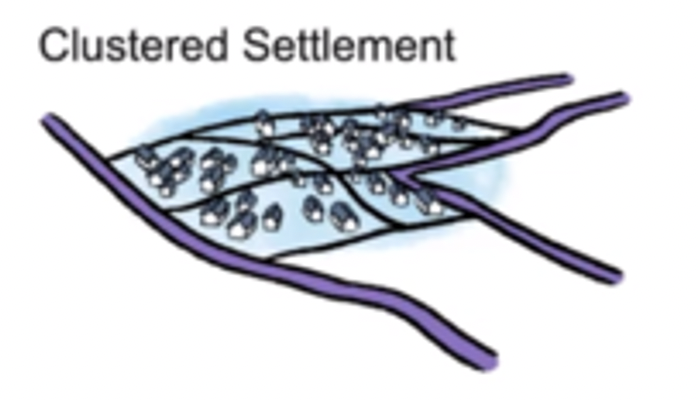
29
New cards
**Dispersed** Rural Settlement Pattern
**farmers live on their own, individual farms**; often isolated, spread out communities due to how governments gave land to farmers
typically found in North America (US and Canada) (5.3)
typically found in North America (US and Canada) (5.3)
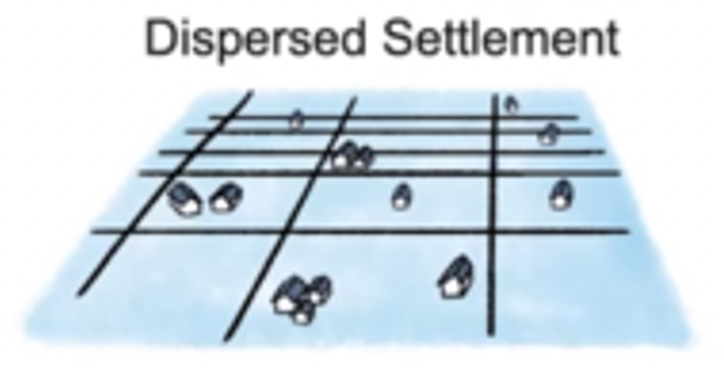
30
New cards
**Linear** Rural Settlement Patterns
**buildings run along a fixed landscape** (roads, rivers, canals, etc), resulting in a straight line landscape (5.3)
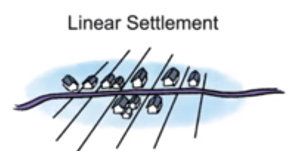
31
New cards
Metes and Bounds
SURVEY METHOD!
__metes__– used for short distances
EX: “from the oak tree,” “100 yards north,” “to the corner of the barn”
__bounds__– cover larger areas, based on larger features like streams or roads (5.3)
__metes__– used for short distances
EX: “from the oak tree,” “100 yards north,” “to the corner of the barn”
__bounds__– cover larger areas, based on larger features like streams or roads (5.3)
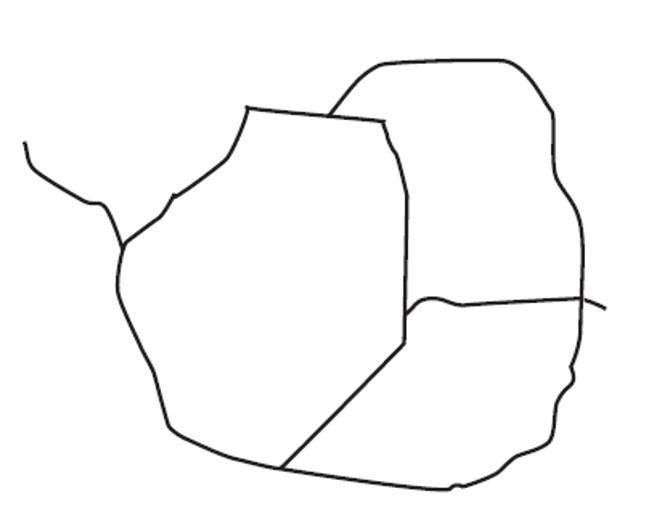
32
New cards
Township and Range
SURVEY METHOD!
government divided land into townships that were 6 miles long and 6 miles wide, with each square mile being able to be divided into smaller lots; some sections were reserved fro schools and railway lines
seen in the US due to the Public Land Survey System in 1785 (5.3)
government divided land into townships that were 6 miles long and 6 miles wide, with each square mile being able to be divided into smaller lots; some sections were reserved fro schools and railway lines
seen in the US due to the Public Land Survey System in 1785 (5.3)

33
New cards
Long Lot
SURVEY METHOD!
system was used to give more farmers access to waterways
seen in French holdings in North America like Louisiana; Quebec; St. Genevieve, Missouri (5.3)
system was used to give more farmers access to waterways
seen in French holdings in North America like Louisiana; Quebec; St. Genevieve, Missouri (5.3)
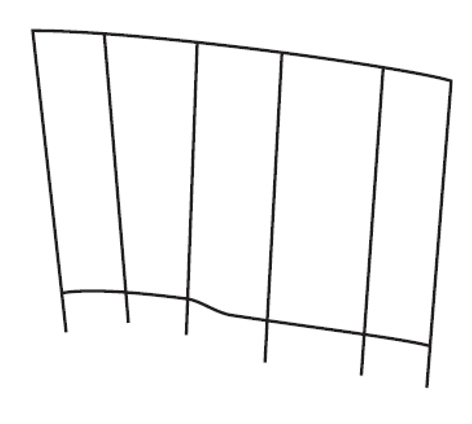
34
New cards
5 Zones of Von Thunen’s Model
1. **Central City/Market**
2. **Horticulture** – intensive farming and dairying (close to market due to perishability, esp. before refrigeration)
3. **Forests** – wood was super important back in the day and it’s weight made it difficult to transport
4. **Grains** – increasingly extensive field crops, like wheat and corn
5. **Grazing** – less intensive and easily transportable (animals can walk themselves) (5.4)

35
New cards
Problems with Von Thunen’s Model
expects isotropic world when physical features are everywhere; ignores that places have competitive advantage (better soils, located on a river, etc); expects one market when there are always many potential markets; product changes (wood’s decreasing importance, increased shelf-life); transportation changes (flowers flown overseas, refrigeration for perishable goods, etc) (5.4)
36
New cards
Bid Rent Curve
*see image above* (5.4)
represents the farmer’s willingness to pay for land at various distances to the market
represents the farmer’s willingness to pay for land at various distances to the market

37
New cards
Desertification
the transition of land from fertile to desert; this can happen naturally or as a result of human actions
EX: the Sahel region in Africa – very prone to desertification (5.5)
EX: the Sahel region in Africa – very prone to desertification (5.5)
38
New cards
Deforestation
the removal of large tracts of forest (5.5)
39
New cards
Terracing
**the process of artificially modifying mountainous landscape to better suit agriculture**; reduces erosion and collects rainfall better but requires significant labor to build and maintain
EX: East Asia (rice), North Africa (fruit and olive trees), South America (potatoes and maize) (5.5)
EX: East Asia (rice), North Africa (fruit and olive trees), South America (potatoes and maize) (5.5)
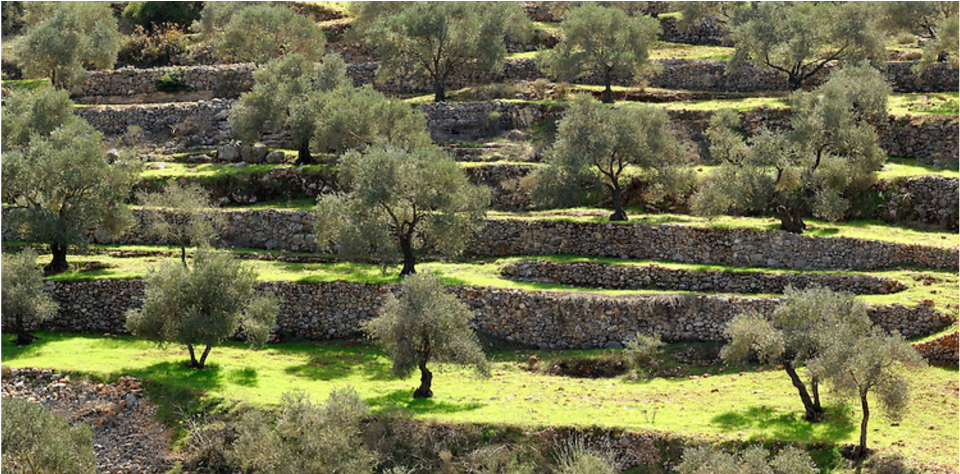
40
New cards
Irrigation
**the process of diverting water from its natural course or location to aid in the production of crops**; disrupts natural drainage and regeneration of water and can lead to land subsidence
EX: Ogallala Aquifer serving Nebraska to northern Texas (5.5)
EX: Ogallala Aquifer serving Nebraska to northern Texas (5.5)
41
New cards
Subsidence
the compaction of soil and rock when the waters are removed; commonly occurs with the overuse of ground water; results in the land “sinking” (5.5)
42
New cards
Organic Foods
foods grown without the use of pesticides, synthetic fertilizers, or any other unnatural processes
__negatives__: more labor-intensive, more expensive, requires more land, can produce more greenhouse gases, farmers use natural chemicals which still damage the environment (5.5)
__negatives__: more labor-intensive, more expensive, requires more land, can produce more greenhouse gases, farmers use natural chemicals which still damage the environment (5.5)
43
New cards
Locovores
participants in the “eat local” movement; closely associated with the organic movement
__pros__: uses less fossil fuel in transportation; supports local farmers
__cons__: inefficient (5.5)
__pros__: uses less fossil fuel in transportation; supports local farmers
__cons__: inefficient (5.5)
44
New cards
Aquaculture
the cultivation of seafood under controlled conditions as a response to overfishing; has been called the blue revolution (5.5)
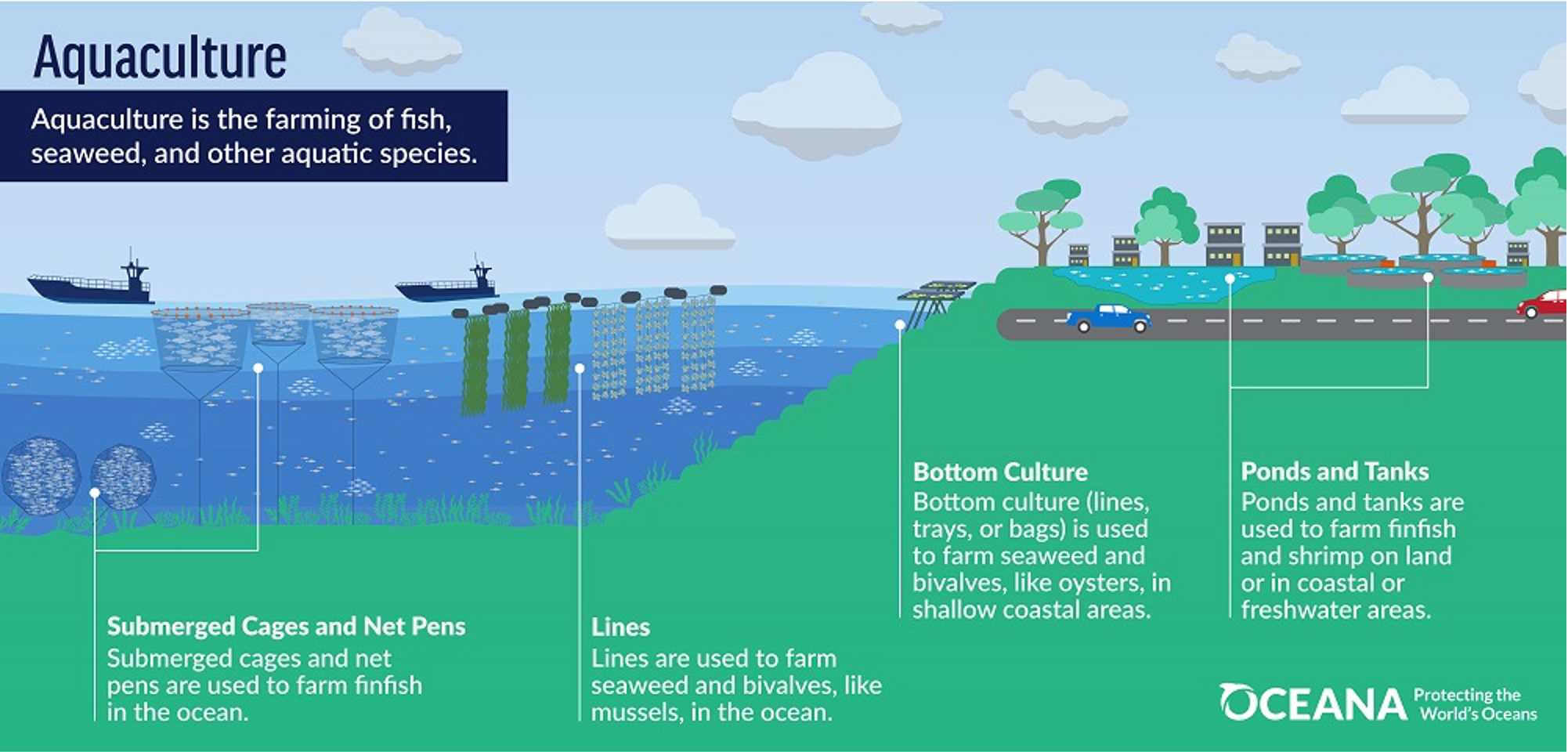
45
New cards
Open-Pen System
where farm fish are able to interact with the environment; essentially an aquatic CAFO
__issues__: high density of fish leads to faster spread of disease and parasites; fish can escape and breed with native stock; disrupts traditional fisherman economy (5.5)
__issues__: high density of fish leads to faster spread of disease and parasites; fish can escape and breed with native stock; disrupts traditional fisherman economy (5.5)
46
New cards
Fair Trade Movement
an effort to promote higher incomes for producers and for more sustainable farming practices; attempt to combat neocolonialism’s impact on the economy of developing countries (5.5)
47
New cards
Doomsday Vault
contains copies of seeds from across the planet in case of disaster (5.5)
48
New cards
Subsidies
government support in the developed world provided to farmers to ensure that consumers have a dependable, low-cost supply of food
\*critics of the program complain that the majority of the subsidies go to agribusinesses instead of small family farms (5.5)
\*critics of the program complain that the majority of the subsidies go to agribusinesses instead of small family farms (5.5)
49
New cards
3 Goals of Subsidies
1. national security – dependable food supply
2. help farmers by increasing agricultural exports
3. help consumers by reducing food costs (5.5)